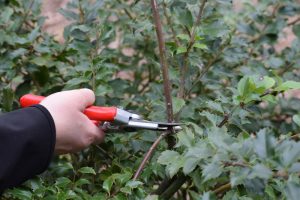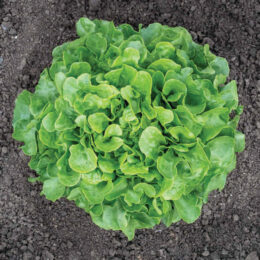By Rosie Lerner

Make a “heading cut” to reduce plant height.
Photo by Kyle Daniel, Purdue Extension
Now’s a good time to survey your landscape and decide what needs pruning following potential freeze injury late this winter, keeping in mind that not all plants need to be trimmed. Pruning generally stimulates new buds to develop and break dormancy, so this year we recommended delaying pruning to reduce freeze injury.
We had mild conditions through midwinter, which caused some plants to emerge early from dormancy. The mid-March temperatures in the teens and low 20s likely will result in some of these plants having dead buds and twig dieback. It is still a bit early to know the extent of the damage, and there’s still potential for additional weather-related issues as early spring can also sometimes bring wintry conditions.
Pruning isn’t difficult, but there are proper techniques to keep in mind. Late winter or early spring, before new growth begins, is generally considered the optimum time to prune most plants. This is when a plant’s wounds heal quickly, without threat of insect or disease infection. However, plants that bloom in early spring, such as forsythia, magnolia and crabapple, should be pruned later in spring after their blooms fade. These early bloomers produce their flower buds on last year’s wood, so pruning early will remove many potential blooms.
Trees that have large quantities of sap in the spring, such as maple, birch and dogwood, are not harmed by early spring pruning but can be pruned in midsummer or late fall to avoid the sap bleeding.
In general, landscape plants should be pruned to maintain or reduce their size, to remove undesirable growth, to remove dead or damaged branches, and to rejuvenate older plants to produce more vigorous foliage, flowers and fruits. In some cases, pruning is necessary to prevent damage to life and property.
In most cases, it is best to allow a tree or shrub to develop its natural shape as much as possible. However, removing selected branches because they are weak or formed at a poor angle to the trunk will help the rest of plant receive more sunlight. Thin this type of growth by removing unwanted branches at their point of origin. Make the cut just beyond the branch collar, which is the ridge of bark that surrounds the junction of that branch to its point of origin.
For more information about pruning, you can download a copy of the newly revised Purdue Extension publication Pruning Ornamental Trees and Shrubs. It is available at https://edustore.purdue.edu/item.asp?Item_Number=HO-4-W.
Rosie Lerner is the Purdue Extension consumer horticulturist and a consumer of Tipmont REMC. Have a question about gardening? Use the form to send it to us. Or, questions about gardening issues may be sent to: “Ask Rosie,” Electric Consumer, P.O. Box 24517, Indianapolis, IN 46224, or ec@ElectricConsumer.org.



